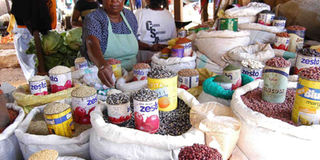Why legumes are a nutritious ingredient in your porridge

A woman sells an assortment of leguminous farm produce. Legumes are a source of protein, so they are a good alternative to meat and fish. FILE PHOTO | NATION MEDIA GROUP
What you need to know:
- They can be mashed or pureed, or an older baby can enjoy them in their whole form.
- Complementary feeding should be timely, meaning that all infants should start receiving foods, in addition to breast milk from six months onwards.
- When mothers begin weaning in Kenya, many start their babies off with porridge, which is easy to prepare.
- Maize, millet, cassava or rice flour. Bean or soya bean mash or groundnut or soya bean flour made into a thick soup.
Legumes contain fibre as well as vitamins and minerals, so they can be counted as a vegetable.
They are also a source of protein, so they are a good alternative to meat and fish.
Legumes are typically low in fat, contain no cholesterol, and are high in folate, potassium, iron and magnesium.
Therefore, legume-fortified complementary and weaning foods provide excellent nutrition.
They are filled with important nutrients including iron, calcium, B vitamins and fibre that help nourish your baby’s growing body.
They can be mashed or pureed, or an older baby can enjoy them in their whole form.
When breast milk is no longer enough to meet the nutritional needs of the infant, complementary foods should be added to the diet of the child.
The transition from exclusive breastfeeding to family foods, referred to as complementary feeding, typically covers the period from six to 18-24 months, and is a very vulnerable period.
A third to a quarter of under-fives in Kenya have stunted growth, so adding protein to their diets is very important.
Complementary feeding should be timely, meaning that all infants should start receiving foods, in addition to breast milk from six months onwards.
It should be adequate, meaning that the complementary foods should be given in amounts, frequency, consistency and using a variety of foods to cover the nutritional needs of the growing child while maintaining breastfeeding.
Foods should be prepared and given in a safe manner, which means that measures are taken to minimise the risk of contamination with pathogens.
And they should be given in a way that is appropriate for the age of the child.
The adequacy of complementary feeding not only depends on the availability of a variety of foods in the household, but also on the feeding practices of caregivers.
When mothers begin weaning in Kenya, many start their babies off with porridge, which is easy to prepare.
Porridge is a dish made by boiling ground, crushed, or chopped starchy plants, typically grain in water or milk.
Nowadays, children are fed on porridge from refined maize meal without adding any other ingredient.
This practice does not provide a wholesome food for the growing babies.
The recipe below outlines how to prepare porridge with legumes (beans, groundnuts or soya beans) that is nutritious.
Ingredients
Maize, millet, cassava or rice flour. Bean or soya bean mash or groundnut or soya bean flour made into a thick soup.
Preparation
Prepare the porridge in the customary way.
Whilst it is simmering in the pot, add bean or soya bean mash or add thick groundnut or soya bean soup.
Stir vigorously.
Cook for two to five minutes.
Remove the porridge from the fire or stove.
Cool and serve to the infant or young child.
Groundnut soup is made by roasting 1½ cup of groundnuts until it is pale brown.
Remove skins and then crush the groundnuts with pestle and mortar (or on a stone).
Mix with water to form a paste. Cook for 10 minutes as you add small quantity of water.
Bean mash is made by soaking ¼ cup of beans overnight and then boil in the usual way.
Mash with fork or spoon.
Force through sieve, removing skins.
One disadvantage of beans is that they take a long time to cook while most people can’t afford the canned or frozen beans sold in the market.
This makes beans expensive, from both the fuel and time perspective.
***
Makau is based at Department of Food Science and Technology, Egerton University.




